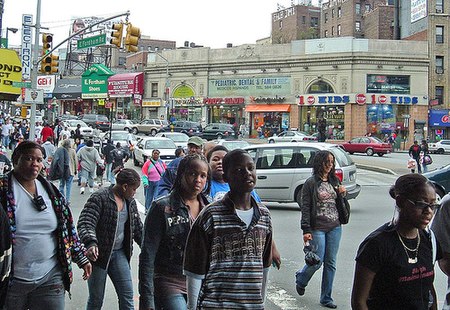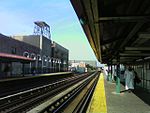Fordham Road

Fordham Road is a major thoroughfare in the Bronx, New York City, that runs west-east from the Harlem River to Bronx Park. Fordham Road houses the borough's largest and most diverse shopping district. It geographically separates the North Bronx from the South Bronx. This street runs through the neighborhood of University Heights, divides Fordham from Fordham-Bedford and finally runs along the northern border of Belmont. It begins to the east as a continuation of Pelham Parkway and continues to the west over the University Heights Bridge into Manhattan, where it runs as West 207th Street. It is a two-way, four-lane road. East of Webster Avenue Fordham Road runs concurrent with U.S. Route 1 from Webster Avenue to Boston Road. Fordham Road is divided into East Fordham Road and West Fordham Road by Jerome Avenue following after the Manhattan grid, with address numbers for both the East Fordham Road and West Fordham Road increasing away from Jerome Avenue. Fordham Road is under the management of the Fordham Road Business Improvement District, a non-profit organization under contract with the City of New York. The BID maintains, develops, and markets the merchants along Fordham Road and hosts many community events throughout the year.
Excerpt from the Wikipedia article Fordham Road (License: CC BY-SA 3.0, Authors, Images).Fordham Road
East Fordham Road, New York The Bronx
Geographical coordinates (GPS) Address Nearby Places Show on map
Geographical coordinates (GPS)
| Latitude | Longitude |
|---|---|
| N 40.862258333333 ° | E -73.898908333333 ° |
Address
East Fordham Road 111
10468 New York, The Bronx
New York, United States
Open on Google Maps










